Nothing seems right in Emma Webster’s No Man’s Land (all works 2018): toadstools are weirdly spotlighted; wispy arboreal cutouts contain more than mere foliage; and a nearby cervine, possibly an antelope, is impossibly dwarfed by a distant moose. Such incongruities lead one to wonder: what sort of location does this painting depict?
Webster painted No Man’s Land and 14 other engrossing scenes in “Arcadia,” at Diane Rosenstein Gallery, from flashlight-illuminated miniature dioramas she had assembled of clay figurines, plastic foliage, and collaged reproductions of historic paintings. Her landscapes’ facades of plausibility dissolve quickly into blatant contrivance. Papery trees cast eerie shadows on perfect backdrops. Incompatible, often mythical creatures with abnormally shiny coats appear too perfect or too saggy. Relative scale is off-kilter; spatiality seems shallow. Contributing to the ambience of a dismal dream, items that would normally appear sharp instead appear soft and blurry; conversely, other elements’ outlines are devoid of due nuance; treetops, for instance, bear unnaturally hard edges. With severe dim lighting, stark outlines, and drab color, her collage-like scenes seem more gloomy than pastoral.
In painting her miniature still life worlds as grandiose landscapes, Webster calls attention to the contradictory nature of age-old Arcadian ideals where tightly controlled fields are envisioned as raw wildernesses. Even the word “pastoral,” defined as “pleasingly peaceful and innocent” and also “devoted to or based on livestock raising,” is tinged with paradox; for as much as cultures over centuries have tended to idealize farming, raising livestock is hardly a peaceful endeavor; for humans, it is hard work, and for livestock, it generally means eventual slaughter. Encapsulating this dichotomy, Bucolic portrays a stamping bull whose ferocity is diminished by its rigidly posed baggy body. The bovine’s sanguine nose is redolent of grisliness, yet its big eye glimmers with the kind helplessness of a plush toy. Isn’t it ironic that cattle are synonymous with serene countrysides?
There is timeless irony, too. Many hunters promote conservation and seeking peace with nature even as they extinguish the lives of wild animals. Webster plays on this ancient paradox in Actaeon, whose title bespeaks the Greek myth of a hunter who was turned into a stag. This painting depicts a lumpy clayish elk appearing more outrageously artificial than the aforementioned bull. Such stiff statuesque animals represent people’s oft-contradictory conceptions of livestock and game.
Painted in no more of a naturalistic or elevated manner than the animals, Webster’s human characters appear unabashedly lifted from historic paintings; like the beasts, they hardly seem real. There are no creatures in Anthropocene, except a blurry woman lounging amid fake trees. People serve as just another element in Webster’s landscapes, mere cogs in a bucolic wheel turned by larger human custom.
Bearing little resemblance to Poussin’s eponymous painting, the comely scenery in Et in Arcadia ego becomes a decorative backdrop for tacked-on fruits, butterfly wings, and an egg. Or are these nature-based trinkets supposed to prettify the flat painted landscape upon which they cast gloomy shadows? In Webster’s paintings, as in real life, it’s often difficult to separate the myriad ways in which nature is symbolically processed and re-processed.
Most impressive, Still Life features layer upon layer of landscapes melting into one another like geological strata. Replete from top to bottom with vignettes featuring animals, people, and unexpected details both antiquated and contemporary, this orchestrated mishmash of times, places, and activities suggests that our cultural conceits of nature haven’t evolved as much as we might believe. Such paintings unmask the farcicality embedded in the notion that wild terrains plowed under by human intervention are presented as idyllic untouched landscapes. Yet as Webster’s still life-landscapes also insinuate, perhaps such conventions are not so farcical at all, given the fact that humans, too, are animals, and the dominant species at that.

